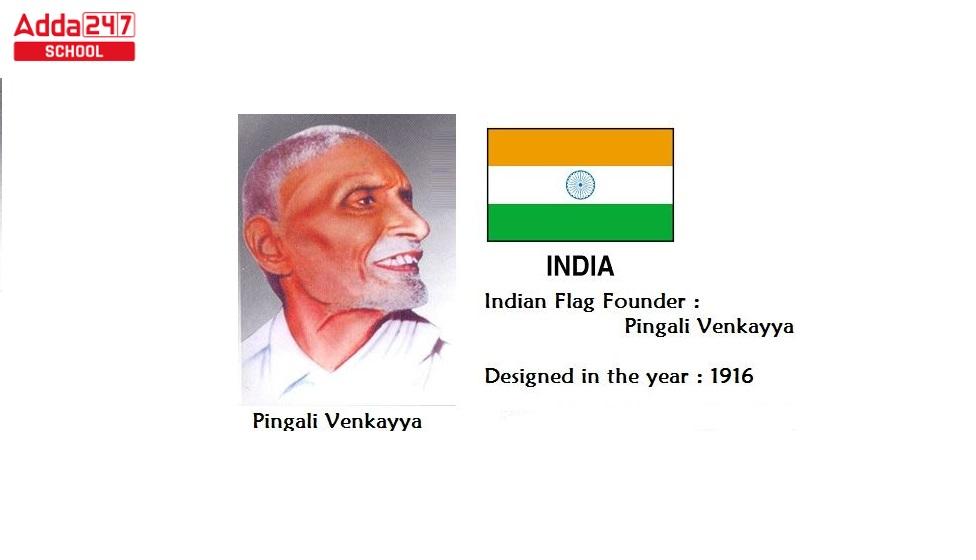India has more than thousands of years of history, and history of the independence of around 74 years. This put to stick our focus on the National Flag of India which is known as a Tricolor. Those who sees the Flag of India, thoughts about the designer of this flag & asks “Who Designed The National Flag of India?”.
That is why we have provided almost every possible information about the National Flag of India and Who Designed Indian Flag in Detail. Please read the article fully to get all the information about Who Designed Indian Flag.
Who Designed The National Flag of India
The national flag of India was designed by Pingali Venkayya, an Indian freedom fighter and agriculturist. Born in 1876 in Andhra Pradesh, Venkayya was deeply involved in the struggle for independence. He proposed the design for the flag, which originally featured a spinning wheel (charkha) at its center, symbolizing self-reliance. The final version, adopted on July 22, 1947, replaced the charkha with the Ashoka Chakra, a 24-spoke wheel in navy blue, representing law and dharma. The flag consists of three horizontal stripes of saffron, white, and green, symbolizing courage, peace, and prosperity, respectively.
Who Designed Indian Flag First
The Indian national flag was first designed by Pingali Venkayya in 1921. Pingali Venkayya, an Indian freedom fighter and a scholar, presented the design of the flag to Mahatma Gandhi, which initially consisted of two colors, red and green, representing the two major communities, Hindus and Muslims.
Later, a white stripe was added to represent the remaining communities, and the spinning wheel or charkha was placed in the center, symbolizing India’s self-reliance. The final version, adopted on July 22, 1947, included the Ashoka Chakra, a 24-spoke wheel, replacing the charkha, and it became the official flag of independent India.
Who Designed the Indian National Flag History
The Indian National Flag, also known as the Tricolor, is a horizontal rectangular flag with three equal stripes of saffron, white, and green. In the center is a navy blue wheel with 24 spokes, known as the Ashoka Chakra.
The history of the Indian National Flag dates starts back to 1906 when it was first designed by an Indian freedom fighter named Pingali Venkayya. The original flag had two colors, red and green, with the slogan “Vande Mataram” written in the center.
In 1921, Mahatma Gandhi proposed a new design for the flag that would represent all religions and castes. The new design included three equal stripes of saffron, white, and green, with a spinning wheel in the center. The spinning wheel was later replaced by the Ashoka Chakra, which represented the eternal wheel of law.
The Indian National Congress adopted the tricolor as the official flag of the Indian National Congress in 1921. The flag was also flown at the Indian National Congress sessions and became a symbol of the Indian independence movement.
On July 22, 1947, the Indian Constituent Assembly adopted the tricolor as the official flag of the Dominion of India. The flag was hoisted for the first time on August 15, 1947, when India gained independence from British colonial rule.
Now, the Indian National Flag is an important symbol of India’s independence and sovereignty. It is flown at government buildings, public institutions, and private residences throughout the country, and is revered by millions of Indians as a symbol of national pride and unity.
Who designed our National Flag: The Symbolism of the Indian Flag
Here’s the symbolism of the Indian National Flag:
| Symbols | Symbolism |
| Saffron | The topmost band of the flag is saffron, which represents courage, sacrifice, and selflessness. It also symbolizes the Hindu religion, which is the dominant religion in India. |
| White | The middle band of the flag is white, which represents truth, peace, and purity. It also represents the minority communities in India, such as Muslims and Christians. |
| Green | The bottommost band of the flag is green, which represents prosperity, faith, and fertility. It also represents the Muslim religion, which is the second-largest religion in India. |
| Ashoka Chakra | The navy blue Ashoka Chakra in the center of the flag represents the wheel of law, justice, and righteousness. It also symbolizes the constant motion of life and the progress of the nation. |
Other National Flags of India
There are several other national flags in India that represent various aspects of the country’s culture and heritage. Some of these flags include:
- Flag of the President of India: We can see the flag of the President of India is as a dark blue rectangular flag with the Ashoka Chakra in the center and the emblem of India above it.
- Flag of the Prime Minister of India: We can see the flag of the Prime Minister of India is a rectangular flag with a white background and a blue Ashoka Chakra in the center.
- Flag of the Indian Army: We can see the flag of the Indian Army is a rectangular flag with a deep blue background, a golden lion facing the left and holding a sword in its right paw, and the Ashoka Chakra in the center.
- Flag of the Indian Navy: The flag of the Indian Navy is a rectangular flag with a dark blue background, a white anchor in the center, and the Ashoka Chakra above it.
- Flag of the Indian Air Force: The flag of the Indian Air Force is a rectangular flag with a light blue background, a golden eagle in the center, and the Ashoka Chakra above it.
Importance of the Indian National Flag
The Indian National Flag is an important symbol of the country’s independence and its values. It represents the sacrifices made by the freedom fighters who fought for India’s independence from British rule. These are the reasons why the Indian National Flag is important for India & Indians:
| Importance | Why Important |
| Represents National Pride | The Indian National Flag represents the pride and unity of the country’s people. It is a symbol of the country’s rich cultural heritage and diversity. |
| Signifies Independence | The Indian National Flag is a reminder of the country’s long and difficult struggle for independence. It serves as a symbol of the sacrifices made by the freedom fighters who fought for the country’s independence. |
| Reflects National Values | The colors and design of the Indian National Flag represent the country’s core values of courage, peace, and prosperity. It is a symbol of the country’s commitment to justice and progress. |
| Honors the Nation | The Indian National Flag is an important symbol of respect and honor for the country. It is hoisted on national holidays, at important events, and at important public and private buildings to show respect and honor for the nation. |
Who Designed India National Symbols Details
India has several national symbols that represent the country’s diverse culture, heritage, and values. Some of the most important national symbols of India include:
-
National Flag
The Indian National Flag, also known as the Tiranga, is a horizontal tricolour of saffron, white, and green, with a navy blue Ashoka Chakra in the center. It represents the country’s independence and its values.
-
National Emblem
The National Emblem of India is an adaptation of the Lion Capital of Ashoka, which was originally erected around 250 BCE. It features four lions standing back to back, with the Ashoka Chakra in the center and other animals surrounding it.
-
National Anthem
The Indian National Anthem, “Jana Gana Mana,” was written by Rabindranath Tagore in 1911. It is a tribute to the country’s diversity and unity.
-
National Song
The Indian National Song, “Vande Mataram,” was written by Bankim Chandra Chattopadhyay in 1876. It means “I Bow to Thee, Mother” and is a tribute to the country’s land and people.
-
National Animal
The Indian National Animal is the Bengal Tiger, which is found mainly in India and is a symbol of strength and power.
-
National Bird
The Indian National Bird is the Indian Peafowl, which is found throughout the country and is a symbol of grace and beauty.
-
National Flower
The Indian National Flower is the Lotus, which is a symbol of purity, enlightenment, and rebirth.









 DTE Maharashtra Polytechnic Merit List 2...
DTE Maharashtra Polytechnic Merit List 2...
 How Normalisation Influence CUET Score 2...
How Normalisation Influence CUET Score 2...
 CUET Result 2025 OUT SHORTLY @cuet.nta.n...
CUET Result 2025 OUT SHORTLY @cuet.nta.n...









